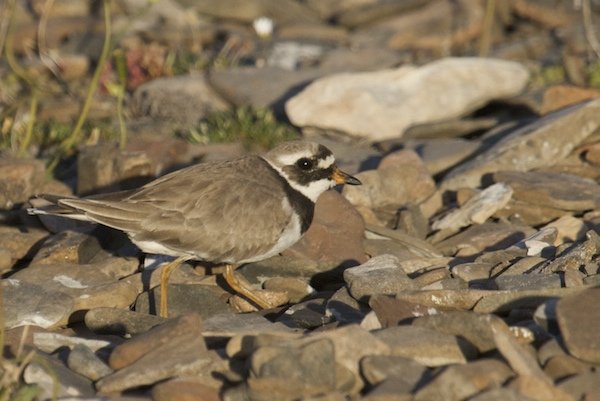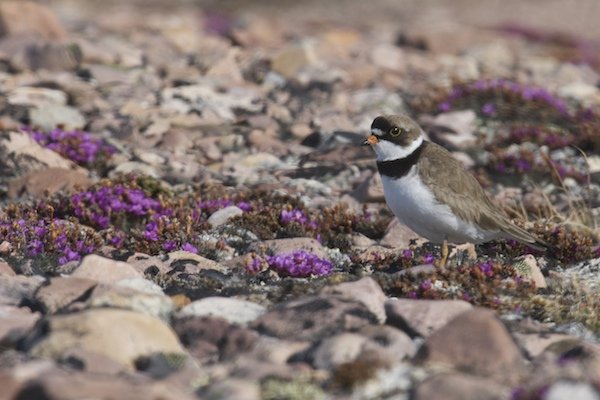Last night I saw my second plover species of the year, a Common Ringed Plover. The first I saw was its doppelganger, the Semipalmated Plover. Interestingly, until a couple of years ago conventional wisdom held that the north end of Baffin Island was only populated by Common Ringed Plovers, the south Baffin by Semipalmated. Somewhere in the middle, there was supposedly a small zone of hybridization.
When I found that the small colony of plovers I was watching near the old townsite of Nanisivik were in fact Semipalmated Plovers, not Common Ringed Plovers as I had assumed for a few years I began digging into the relationship between the two species. During that search I came across a plover footnote in a notable case of scientific misconduct in the High Arctic.
Dr. Neal G. Smith is the Staff Scientist Emeritus with the Smithsonian’s Tropical Research Centre in Panama. In 1966 he published what was thought to be a ground breaking study on arctic gulls. The work was widely cited, followed up with an article in Scientific American and the research appeared (and I may be wrong still appears) in textbooks. The research, although widely accepted, was greeted with some skepticism early on (Sutton 1966), and eventually followup attempts to replicate his research and experiments near Clyde River Nunavut by Richard Schnell found that the data could not have been have been collected as Smith’s publications had indicated.
In a 1991 reply to the criticisms Smith acknowledges mistakes, but insisted that those mistakes did not affect his conclusions.
At the same time as he was doing his study on Kumlein’s (Iceland) Gulls and Thayer’s Gulls Smith supposedly gathered data on both Common Ringed and Semipalmated Plover (which both nested in the area) and the hybridization of the two species. His paper Polymorphism in Ringed Plovers (1969) found that where the two species hybridized the resulting offspring had either characteristics of one or the other, not an intermediate form. More over more than one type would be found in the brood.
When I read the article, before I had found out more about the misconduct, I was quite intrigued, and had hoped to see if I could see any mixed broods up here. But I found myself wondering things like: If Common Ringed Plovers migrate from here through Europe, and Semipalmated through North America, what happens to the different type of offspring from a single mixed brood? Do the Common Ringed type migrate through Europe and the Semipalmated head south? The article seemed to generate more questions for me than answers (which in itself isn’t a bad thing).
As I looked further into the question and found the gull studies and the criticisms I found that questions had also arose about Smith’s plover work. Snell found that Smith had not even arrived in the field at the time some of his data was supposedly gathered. As far as I can tell, (with albeit very limited access to literature as I am a non-scientist) no one has found the same results with plover polymorphism as Smith. As far as I can tell, no one has tried to replicate this work with plovers in the High Arctic, but it would be fascinating to see the results.
The discovery of this tale, coming out of my discovery of Semipalmated Plovers breeding up here, has been one of the most fascinating stories about bird life for me since I arrived up here. It is worthy of a much longer look than this one here. Those of you who are interested in more details I encourage you to look at the following articles (my apologies if they are not cited properly, again I am not a scientist or academic):
A Beginner’s Guide to Scientific Misconduct, Montgomerie and Birkhead, 2005, ISBE Newsletter, Vol 17(1)
Conflation of the Observed and the Hypothesized: Smith’s 1961 Research in Home Bay, Baffin
Island, Snell, 1991, Colonial Waterbirds, Vol 14, No. 2 pp 196-202
Arctic Gulls 32 Years Later: A Reply to Snell, Smith, 1991, Colonial Waterbirds, Vol 14, No. 2, pp 190-195
Polymorphism in Ringed Plovers, Smith 1969, Ibis, Vol 111, Issue 2, pp 177-188
The Larus articles and other criticisms are listed in the Montgomerie and Birkhead paper. I’d also like to point out a webpage of the Ontario Field Ornithologists on the Taxonomic History of Thayer’s Gull, that has some commentary on Smith’s original studies and is interesting in its own right (although perhaps not to the “splitters” amongst you).















When we get one show up at the Poo Ponds in Broome and stay for over a year then nothing is incredible/impossible any longer! I hope it makes it back to you one day! When it was on the nearby beach it was with Greater Sand Plovers.
…and in my one claim to participation in scientific debunking, I suggested to Richard, before he headed to Baffin Island, that the key to the puzzle would lie in the Plovers, rather than in the cover-of-Scientific-American Gulls.
Following up on the email I received from you Fred (thank you), it appears Dr Smith, the subject of this post, died on October 1st of this year. A short notice appears in the Smithsonian Tropical Research Institute page here… http://www.stri.si.edu/english/about_stri/headline_news/news/article.php?id=1560
So is there actually any proof that these two species interbreed besides Smiths early work. I can’t seem to find any in my internet searches.
Adrian, I have been unable to find any papers on the subject since Dr. Smith’s work. I certainly have seen no evidence of it here, where both species occur regularly. Now that is purely anecdotal. Smith’s investigation into polymorphism should be fairly easy to investigate these days.
Thanks Clare for the quick response. Yeah it should be easy to check out and get some results. Im curious why no one has revisited this issue.
While I don’t know for certain, I suspect that the community already feels the study has been debunked sufficiently and have other research priorities.